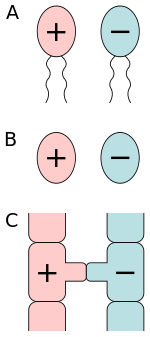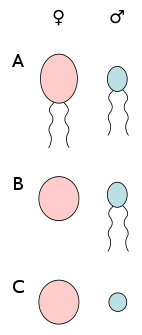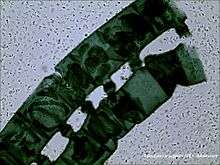Isogamy
Isogamy is a form of sexual reproduction that involves gametes of similar morphology (similar shape and size), differing in general only in allele expression in one or more mating-type regions. Because both gametes look alike, they cannot be classified as "male" or "female". Instead, organisms undergoing isogamy are said to have different mating types, most commonly noted as "+" and "−" strains, although in some species of Basidiomycota there are more than two mating types (designated by numbers or letters). In all cases, fertilization occurs when gametes of two different mating types fuse to form a zygote.

A) isogamy of motile cells, B) isogamy of non-motile cells, C) conjugation.

A) anisogamy of motile cells, B) oogamy (egg cell and sperm cell), C) anisogamy of non-motile cells (egg cell and spermatia).
Evolution
It appears that isogamy was the first stage of sexual reproduction. In several lineages (plants, animals), this form of reproduction independently evolved to anisogamous species with gametes of male and female types to oogamous species in which the female gamete is very much larger than the male and has no ability to move. There is a good argument that this pattern was driven by the physical constraints on the mechanisms by which two gametes get together as required for sexual reproduction.[1]
In Ascomycetes, anisogamy (sexes) evolved from isogamy before mating types.[2]
Biological types
With motile cells
There are several types of isogamy. Both gametes may be flagellated and thus motile. This type occurs for example in algae such as some but not all species of Chlamydomonas.
With non-motile cells
In another type, neither of the gametes is flagellated.
Conjugation
Another, more complex form, is conjugation (similar to the exchange of genetic material through a bridge in bacterial conjugation, but involving reproduction). This occurs in some the green algae, the Zygnematophyceae, e.g., Spirogyra. These algae grow as filaments of cells. When two filaments of opposing mating types come close together, the cells form conjugation tubes between the filaments. Once the tubes are formed, one cell balls up and crawls through the tube into the other cell to fuse with it, forming a zygote.
In ciliates, cell fission may follow self-fertilization (autogamy), or it may follow conjugation (exchange of nuclei).
In zygomycetes fungi, two hyphae of opposing mating types form special structures called gametangia where the hyphae touch. The gametangia then fuse into a zygosporangium. In other fungi, cells from two hyphae with opposing mating types fuse, but only the cytoplasm is fused (plasmogamy). The two nuclei do not fuse, leading to the formation of a dikaryon cell that gives rise to a mycelium consisting of dikaryons. Karyogamy (fusion of nuclei) then eventually occurs in sporangia, and leads to the formation of diploid cells (zygotes) that immediately undergo meiosis to form spores.

In many cases, isogamous fertilization is used by organisms that can also reproduce asexually through binary fission, budding, or asexual spore formation. The switch to sexual reproduction mode is often triggered by a change from favorable to unfavorable growing conditions. Fertilization often leads to the formation of a thick-walled zygotic resting spore that can withstand harsh environments and will germinate once growing conditions turn favorable again.
See also
Notes and references
- Sa Geng; Peter De Hoff; James G. Umen (July 8, 2014). "Evolution of Sexes from an Ancestral Mating-Type Specification Parthway". PLOS Biology. 12 (7): e1001904. doi:10.1371/journal.pbio.1001904. PMC 4086717. PMID 25003332.